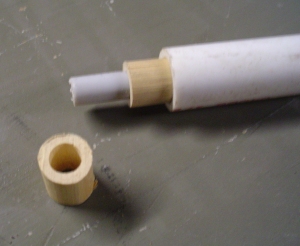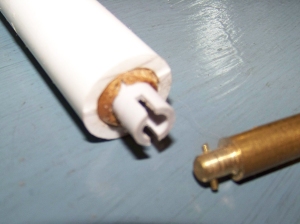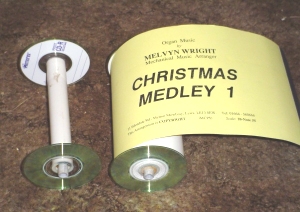El-Cheapo Spools for Homebuilt Grind
Organs
When I built my Smith Senior 20 organ I read in the information
package that we will need to buy supply spools in order to get the hex
shaped hole needed for the rewind mechanism. I devised a way to make my
own spools with hex holes, but soon changed to a slot drive.
John Smith didn't give dimensions for spools, but with a bit of hunting
on the internet, I found photos which let me establish the general
dimensions of the Rafine spool ends.
The centers are made from two pieces of plumbing and a spacer.

I make the part of the spool on which the paper is wound from a 141 mm
length of nominal 1 / 2 inch “Schedule 40” plastic water pipe. (Smith
format rolls are 140 mm wide.) The
outer diameter of this pipe is actually about 7/8 inch (21.5 mm). The
inner diameter of this pipe is about 5/8 inch (15.5 mm). (The details
provided here may only work well in the USA because pipe and tube sizes
vary between countries, but the design may be modified to use available
metric sizes.)
For the center shaft I use nominal 3/8 OD inch plastic tube sold as
sink and toilet (water closet) water supply
lines. This is cut to a length of 160 mm.
To cut these to length I use a simple jig on a mini-table saw. The jig
also includes a position for cutting the slots and holes for
positioning the spacers at the proper distance from the ends of the
center tube. The slots are cut before assembly.
I make wooden spacers by drilling a 3/8 inch hole in a short piece of
5/8 inch wooden dowel. The picture shows the how the
spacer aligns the two pieces of plastic plumbing. I make the spacers on
a mini-lathe in batches of 20 or more. If drilling the hole
is too much of a challenge, paper and white (PVA) glue could be wound
about the
inner tube until a sufficient diameter is reached.
I made a gear driven rewind mechanism for my organ, which is described
on Mel Wright's Smith Organ builders' tips web page at
www.BuskerOrgan.com
When making the hex end I heated one end with an electric heat gun (a
hair dryer probably would work as well) and forced a short hex
screwdriver bit into the hole. When it cooled it formed a hex recess
which is a tight fit on the bit. It matches well with the gear rewind
drive described in another “hint” on Mel's website because the same
size hex bit is used for the shaft.
I found the hex process a bit inconvenient, and changed to a
pin-in-slot drive. The short drive stub is a force fit in my smaller
gear. I used brass. I first drilled the hole for
the cross-pin, then turned the nipple to fit easily into the center
tube, then drove the cross-pin into place.

Either the hex or slot drive can also easily be used with a battery
powered screw driver for lazy rewinding.
The spool flanges are made from Pocket CD-R disks which have an 80 mm
outer diameter. I use a taper ream to enlarge the hole slightly to 5/8
inch to fit over the spacer. The use of CDs may sound expensive, but I
once found these available for as little as $0.25, and they are
currently readily available for less than $0.50 each in bulk spindle
packages. The disks are not a perfect choice because they are a bit
fragile, but they are smooth, round, and pre-formed.
I use “Super Glue” to assemble the parts.
My total parts cost is less than $2.00, about a fifth of the cost of
"factory made" spools. Making my own also means I can produce a batch
in a few hours, rather than waiting as much as a week for a vendor to
ship them to me.
The final photo shows two of the spools, one with some of the greatest
20er music available, the other waiting for my next home-made roll.



